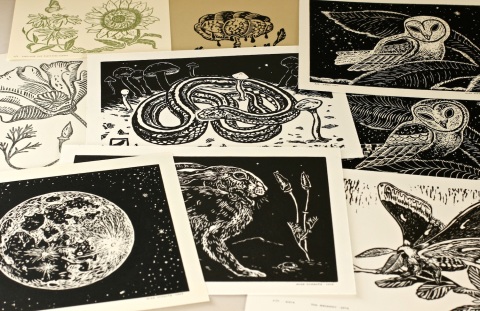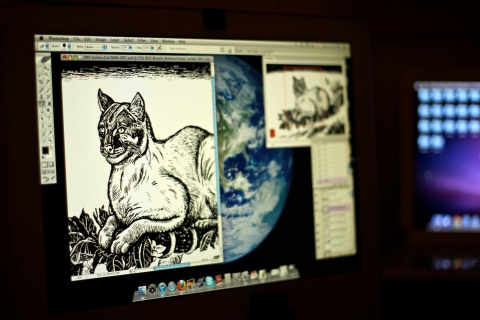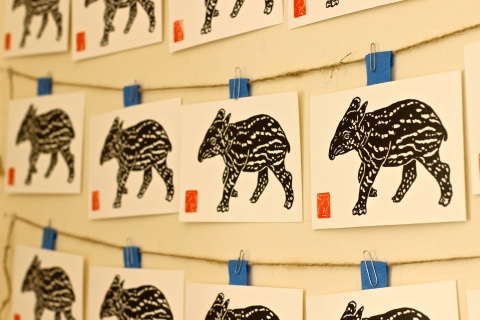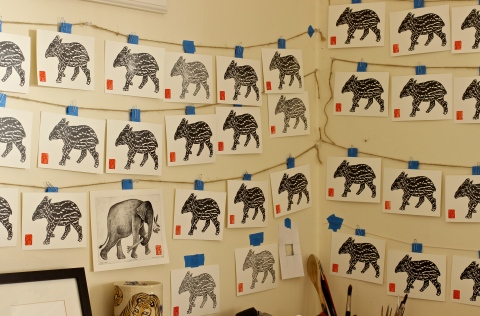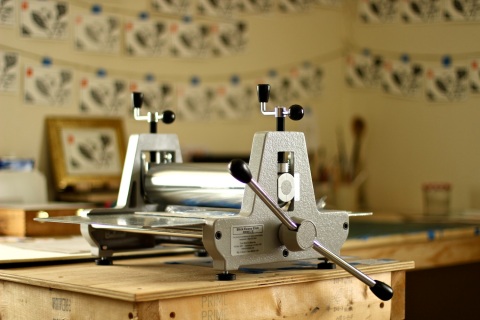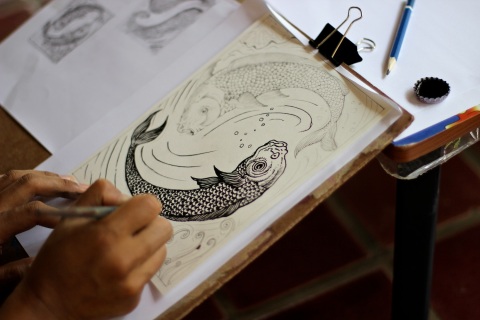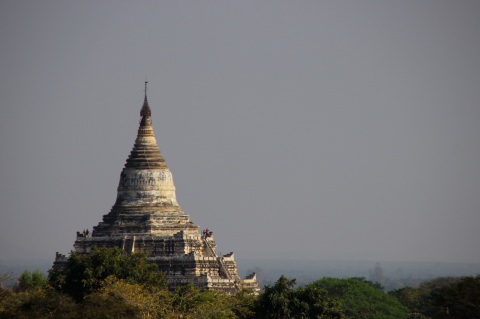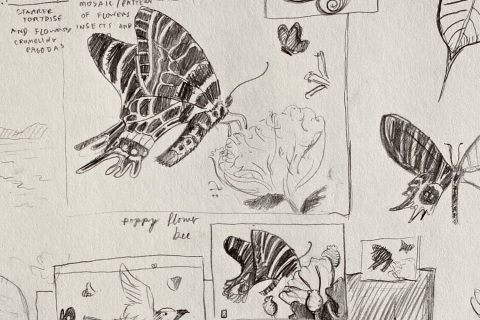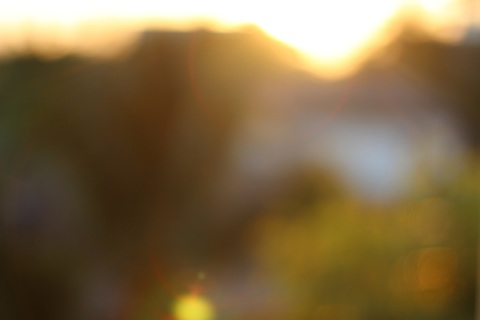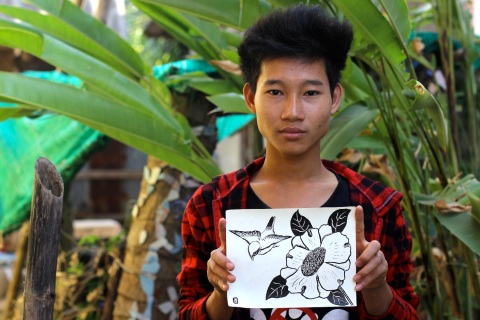New Website!
May 29, 2016 Comments Off on New Website!
I’ve updated my website!
Have a look at mikeschultzstudio.com. If you are on Instagram, that is my go-to social media outlet these days. You can follow me on Instagram here.
TBFF on Etsy + Monotypes as a Learning Tool
December 15, 2014 § 2 Comments
TBFF on Etsy
It’s been a bustling week in my studio in the midst of the holiday season. If anyone would like to give an existing TBFF print as a gift this year, now is the time to order from my Etsy Shop so it can reach you before the holiday!
My Etsy shop is stocked with the first two linocut prints for the Thailand Burma Flora Fauna project– the Camellia Kissi flower and baby Malayan Tapir!
Plus one-of-a-kind monotypes featuring Asian elephants, moonlit Bagan, Burma landscapes, regal cats, and Thai Buddha statues.

Thailand Burma Flora Fauna prints are available listed on my Etsy Shop!
Also available are handmade linocuts of owls, moons, snakes, mushrooms, poppies, and a beautiful Atlas Moth carved by friend and artist Don Mackessy during the predecessor project to my Thailand Burma Flora Fauna Kickstarter— a collaborative effort to make imagery about the plants and animals of sunny California.

An intricate linocut of an Atlas Moth carved by friend and artist Don Mackessy during a collaborative project.
Monotypes as a Learning Tool
In this final stage of the Thailand Burma Flora Fauna project, I am finishing the last of the print designs, and reworking existing images before creating the permanent plates that are to make up the bulk of this series of prints.
Currently, I am in a somewhat awkward position in that this next step requires that all of the print designs are to be completed at once, so that supporters of this project can see the available options simultaneously before choosing which prints they would like to receive.
We are nearly there– and I appreciate all of your patience! It is important to me that the print designs are equally strong, and that together they make up a cohesive body of work.
I have been making monotypes as learning tools to help me understand what is or is not working about a particular print design for the TBFF project. They have been especially useful for a print featuring a landscape of Bagan, Burma, as well as another image of an Asian Elephant.

The ghost print of the Asian Elephant monotype is a one-of-a-kind print after the copper plate is wiped clean.
Monotype: A monotype is a one-of-a-kind print made by painting or drawing directly onto a flat copper plate, and then running that plate through a printing press leaving the ink image on paper. My monotypes are unique in that after the print is pulled, I draw back into each image with black and white printing ink, followed by hand stamping an signing each piece.
Monotypes are different from copper plate etchings in that once the prints are pulled, the flat plate is wiped clean, never to be printed again. If it were an etching or engraving, you could reprint more at will.
Usually, after the initial monotype print, you can pull one or two additional “ghost prints”– much lighter variations with less ink and often greater character. The outcome for each one is very different!

Monotypes featuring a Thai Buddha statue. You can see the variation between the first print and the two additional ghost prints.

A detail of a monotype ghost print that helped me to work out the composition of an upcoming TBFF print., featuring Bagan, Burma.
Thank you all so much for your ongoing support of my project! I appreciate all of you who reach out to me through email and across social media platforms– on Facebook, Etsy, and Instagram. Thank you!
Giving Thanks on Thanksgiving (belated)
December 8, 2014 § 2 Comments
I feel so very grateful for all of your of support this past year for my project, Thailand Burma Flora Fauna. It has been an intense, focused, and fulfilling year full of challenging work!
As I am entering the final stage of production, I thought I would share a handful of images of students working during some of the TBFF drawing and design workshops that I held in Mae Sot, Thailand.
This is but a small fragment of what your contribution to this project has helped to create.
You were a part of this! Thank you!
Teaching art to children can be really rewarding– and I was fortunate to be able to do so with Mae Sot NGO Kick Start Art. Even more fulfilling for me was connecting with the young teachers in that same organization.
For all of the time and energy that I directed towards these young folks, I was met with matched enthusiasm to learn and to be challenged during the teacher-trainings. I believe that in assisting them to hone their skills as working artists and instructors, we are contributing to a greater good and a larger picture, as they are sure to share their knowledge and pass on their skill set with their current and future students.
For the young adults and working artists among them, continued art training can help to provide a livelihood that is a positive alternative to the type of exploitative labor that is often the only available option to migrant workers.
For many of the younger migrant children, art classes in a clean, safe environment can be a much needed rest from their lives– ones that are often filled with adversity, anxiety, and under-stimulation. It is an incredible thing to witness a group of excited, distracted kids suddenly fall silent in quiet concentration, enveloped in the peaceful, engaging, and simple act of making a picture.
Thank you again for your contribution to this project! You help and support made this happen!

Heads down, pencils moving! Mostly quiet with some occasional a capella singing of Burmese radio pop songs.

Student S.K.P. drawing a garden snail from life which she later used to make a flora fauna ink drawing of the same subject. Hold still!

This little lady shows off a fun drawing of an elephant-mermaid-eagle made during an animal hybrid workshop. Drawing can help children to develop different modes of thinking!

Students investigating animal subject matter and drawing thumbnails from references at the Puzzlebox Art Studio.

The Kick Start Art crew and one of the groups they had during summer school. I was happy to be able to contribute and teach with them!
Thank you all for your continued support!
Young Malayan Tapir – Linocut
December 1, 2014 § 6 Comments
Thank you all for your continued support of my Kickstarter project, Thailand Burma Flora Fauna!
The second of the smaller prints featuring a young Malayan tapir is complete and being shipped out this week! A handful of these limited edition linocut prints are now available in my Etsy shop.
The Malayan Tapir
The Malayan tapir is an endangered species still found in remote locations in Thailand and Burma. Its populations once thrived in SE Asia, but after overhunting, poaching, and habitat loss from deforestation, the number of native tapirs have dwindled. It is now a protected species rarely found in the wild.
Markings
The adult Malayan tapir boasts a striking solid black body with a large band of white across its back. The breaking up of its coloration is a natural camouflage in the forests of SE Asia.
The juvenile Malayan tapir (like the one featured in this print) has a black body covered with spectacular white stripes and speckles, which also help to camouflage them while they are young.

Drawing on a plane: loose preliminary sketchbook drawings for the tapir print. Note the sketch of an adult Malayan tapir (bottom left) with a solid black and white body.
Characteristics
The Malayan tapir is an herbivorous creature with a flexible snout like that of an elephant’s trunk. It has poor eyesight, but an excellent sense of smell and hearing. They can grow in length to be 2.4 meters (7 feet 10 inches), and have been found to weight up to 1,190 pounds!
They are crepuscular animals– meaning creatures who are mostly active during the twilight hours of dawn and dusk. The tapir is described as being “mostly, but not exclusively, nocturnal” as it commonly naps during the middle of the night. Don’t we all?
As seen above, I built a simple tool to aid in the stamping of my hare chop / signature. The wooden handled rubber stamp is securely held in a cardboard hinge which is aligned with a precisely placed print.
After carefully inking the rubber stamp, the hinged tool helps to apply a relatively straight and consistently printed hare stamp. It worked well!
Friend and artist Jack Baumgartner commented that this looked like some “good technology”. I really liked that description, and it prompted me to look up the definition of the word.
Technology defined by Merriam-Webster is “a capability given by the practical application of knowledge”.
Working in good company– as seen above, my busy printmaking studio with additional inspiring artwork by friends Andrea Lauren, Joey Chiarello, Nieves Waleska, and Jack Baumgartner.
Thank you all for your continued patience and support for the Thailand Burma Flora Fauna project!
Camellia Kissii Print Complete! Plus Monotypes + Etsy
November 9, 2014 § 9 Comments

Camellia Kissii, Linocut on French Co. Paper, 4 x 6 inches (10.15 x 15.25 cm), 2014
The first edition of linocuts for the Thailand Burma Flora Fauna project is complete, packaged, and being shipped out early this week!
I’ve also listed several of them on my Etsy site in case you would like to add one to your art collection or to send one as a gift to a friend. :) It features the Camellia Kissii flower found in Burma, said to be named after a botanist named Kiss.

Drying linocuts, garden herbs, hot Thai chili peppers, and a favorite Navajo blanket on my studio wall.
THANK YOU all so much for your continued patience and support as I learn and hone my skills as a printmaker.
I am striving to bring you the highest quality work possible, and making this first print was a huge learning curve for me. I’m happy to say I’ve worked out a lot of the initial kinks in the process.
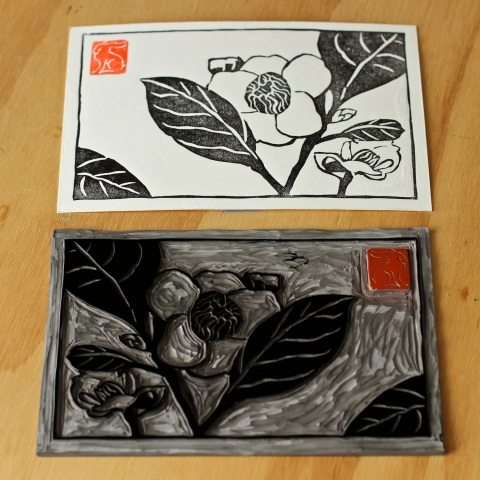
The linocut plate inked up (bottom) with a pulled print above it. One tricky aspect of printmaking– is how to carve an image in one direction, that will look “correct” to our eyes when it is printed in reverse on paper.
Variations
Making prints by hand is just that– a handmade craft. There is always an ebb and flow of variability and variation between the prints. Some are darker, some are lighter, some prints have more “character”. Some of the prints were lovingly touched up with a white opaque gouache, and others were trimmed down a bit– but all of them passed my eagle-eyes quality control check.
As far as character goes, I even added two versions to the edition that have a random ghostly spot on the upper leaf (pictured above, upper right corner). I’ve come to enjoy the prints with a little character, as it makes each one a more unique.

Studio walls with drying prints (plus a tiger print by Andrea Lauren peeking into the frame above my work desk).
Pictured above, Camellia Kissii linocut prints drying on a state-of-the-art blue tape, paper clip and twine combination. This helps the prints to dry free of dust and smudges as oil based inks take longer to cure. It also helps to fit a lot of work into a limited space!

Throwback to drawing the preliminary pencil mock up before carving the Camellia Kissii print into linoleum.

Unsatisfied with the first hare chop I had carved, I made several variations of it. Once I was happy with it, I spliced the hare chop into the linoleum block. (A chop is a traditional stamp-signature.)

The Clean Hands Club: This is what signing 100 prints looks like. From top right to middle bottom to left: signed, signing, and the to-be-signed pile.

The Camellia Kissii print framed in a simple white frame!
Monotype Printmaking
Next week, I’ll be sharing how I’m using monotype printmaking (one-of-a-kind prints made by drawing with ink on a flat copper plate) to physically work out the remaining imagery for the Thailand Burma Flora Fauna project!
Below, you can see the original oil ink drawing on the flat copper plate, and the resulting transfer onto paper. The print shown is the second monotype pulled– a lighter after-image called a “ghost print”, also available on my Etsy shop.

A monotype “ghost print” featuring Bagan, Burma that will be the central image in an upcoming TBFF print!
THANK YOU all so much for your continued support!
Linocut Prototypes + Bagan Drawing Giveaway!
September 14, 2014 § 4 Comments
The Thailand Burma Flora Fauna project is taking shape! These past few weeks have been packed with carving print blocks, printing and testing prototypes, planning and ordering supplies, and networking. THANK YOU for all of your patience and continued support while I work to get you the best prints possible!
Drawing Giveaway + Connecting on Instagram
This week I am giving away an original drawing to one of my followers on Instagram as a thank-you for reaching more than 1K followers! If you are an instagram user, please feel free to follow my feed and enter for the giveaway. (My username is mike_schultz_paintings).
I am also selling two variations of the same drawing on my Etsy shop— first come, first serve!
The Bagan drawings are directly related to the Thailand Burma Flora Fauna series as they are preliminary illustrations for the additional print I am designing which depicts the moon rising over the Bagan Plain in Bagan, Burma– something I was very fortunate to witness with my own eyes!

Drawing giveaway on instagram depicting the Bagan Plain featured in an upcoming print for the TBFF series.

Sneak Peek! This is a print design (work in progress) that will feature a landscape based on Bagan, Burma.
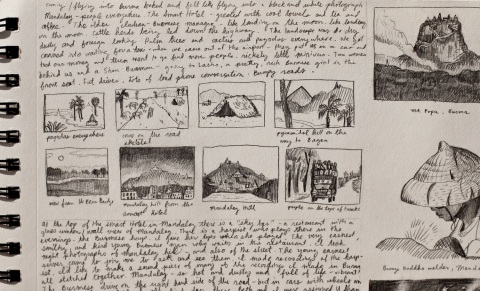
Detail from my Burma travel sketchbook with notes and thumbnail drawings of things I wanted to remember.
Prototypes + Hare Stamp Variations
The initial round of prototypes for the first of two postcard-sized prints is under way. The drawing is first transferred to a linoleum block plate, in reverse, so that when it is carved and printed, the design will be facing the correct direction.

Transferring an ink and gouache drawing of the Camellia Kissii flower to a lino block (in reverse) before carving.

Carefully carving the linoleum block late into the night. (No mistakes, please! There is no undoing a carved line).

Prototypes! Working out the lines and stamp designs for the first of the smaller prints to go out. This one is so close!

Documenting my Burma travel sketchbook drawings with help from studio assistant and constant shadow, Gus!
Thank you again for your continued support!
Updated Production Timeline and Printing Press!
August 30, 2014 § 3 Comments
Today I have a lot of good news to share about the Thailand Burma Flora Fauna printmaking project. I’ll be discussing the updated production timeline, new equipment and supplies, and where we are at in the process.
1. Updated Production Timeline – The original delivery estimate that I gave was August of 2014. Due to a myriad of typical production snags (followed by necessary problem solving), the delivery date for your prints has been pushed back a few weeks.
However, I am happy to say that the end is in sight! We are working around the clock to bring you the best work possible, and this huge project is finally taking shape. THANK YOU for your patience and continued support!

I’ve been looking to my Burma travel sketchbooks a lot while drawing the final designs. What a potent experience it was traveling through Upper Burma.
Pictured above, top left to right– Mt Popa and its mountaintop monastery, gardens and boats along the mighty Mekong River in Luang Prabang, Laos.
Pictured above, bottom left to right– a welder at a brass foundry welding together a large Buddha, a tall thin smokestack pouring a black cloud of soot over a shanty town outside of Mandalay, and a mysterious all-young-female road crew building a road by hand with woven baskets of hand broken gravel.
2. Printing Press + New Printmaking Studio – This month I purchased a beautiful little table top printing press (a little workhorse!) and built a printmaking studio in a well-lit space to make your artwork. So far, the press is fantastic, and it has been a joy getting it dialed in.

This direct drive workhorse is a little behemoth weighing in at 70 pounds. It’s got two solid steel rollers and a steel bed. So far, I love it!

Studio mission control with my immense and ever shifting to-do list (and a small silhouetted self portrait). It’s a good thing I learned about lean manufacturing and organization from working with Grovemade, here in Portland, OR! Using lean production techniques has helped to keep this to-do list wrangled.
3. Professional Training – I am being trained by a skilled local printmaker for whom I have immense respect. He is helping me to dial in my process to make the best pieces possible with my tools. (I’ll share more on him and his work in an upcoming post.)

Experimenting with monotype, a process of making a one of a kind print. Shown here I am drawing with loose blue printmaking ink directly onto a copper plate.
4. Council From Other Artists – The past few weeks I have received a lot of help from some incredible artists and friends. They’ve patiently considered my questions and have been dishing out valuable advice on printing processes and tools. Endless gratitude to artists Jack Baumgartner, Keegan Wenkman, Vladimir Zimakov, and Andrea Lauren for some foundational printmaking advice! (Their names link to their awesome artwork– have a peep!)
5. Supplies – Heeding the advice of my peers, I have been stocking up on and experimenting with a number of high quality supplies and tools. The printing studio set up and equipment include items like the press and its required felt pads, brayers for rolling out ink, a glass palette and palette knives, wooden tables and rolling carts, shelving for supplies, and more.

Shipments arrived! A bulk order of large sheets of fancy paper from the French Paper Company, and a variety of printing inks from great companies like Portland’s own Gamblin.
The supplies also include a variety of special inks and solvents for printmaking– and just yesterday I received a box of large sheets of fancy cream colored paper from the French Paper Company. It’s a high quality, smooth textured paper with a beautiful color that will lend itself well to this project.
I have also been experimenting with professionally made stamps that will act as the signature seal, or “chop”, as it is called in printmaking (more on those in a future post).
6. Prototypes and Practice – This past week I’ve been working out the details for the two 4 x 6″ postcard-sized prints that some of you will receive as your rewards for backing this project.
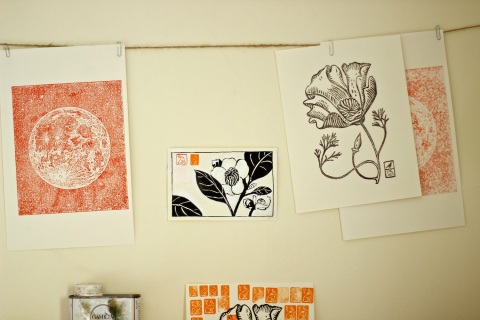
Pictured center: A life sized (Japanese sumi ink and gouache) hand drawn prototype of one of the 4 x 6″ prints.
This small piece will feature a beautiful flower called the Camellia Kissii, found in Burma, and will be made as a linocut relief print on French paper. Also– if you look closely you can see practice stamps with one of the new hare chop stamp prototypes.

Making concept drawings for the additional print in the series. This piece will act as a “title page” of sorts and feature a Bagan, Burma landscape in the center.
Thank you all so much for your patience and your continued support with this project!
Burma in Black and White – Part 1
August 3, 2014 § 6 Comments
This has been a busy week full of painting projects, Burma research, summer gardening, and print designs! Today, I’d like to share more images with you from our travels through Upper Burma– truly one of the most unique places I’ve ever been to.
Some photos just work better in black and white. Here is a collection of those images with accompanying descriptions. So much of the designs for the Thailand Burma Flora Fauna project have been influenced by what I saw and felt during my travels in Burma.
I appreciate all of your feedback and your reaching out to me. Thank you all so much for your continued support!
Burma in B/W

Men driving an old diesel tractor through the center of Nyaung Shwe, on Inle Lake. It is not uncommon to see vehicles from another era still in everyday use in Burma.

Dusk view of Mandalay from Mandalay Hill. You can see the Irrawaddy River shining on the horizon. It’s the main artery that runs through Burma all the way to the Andaman sea.

There is a small mountain town on Mt. Popa, a forested volcano topped with a monastery, that is overrun by tribes of naughty monkeys. Our guide said, “The monkeys here… they can be quite rude.” I concur. Many residents walked with sticks to fend them off.

Filling up at the gas station on Inle Lake, which was comprised of a young boy on a wooden dock with a bucket of gas and a hose. Why not?
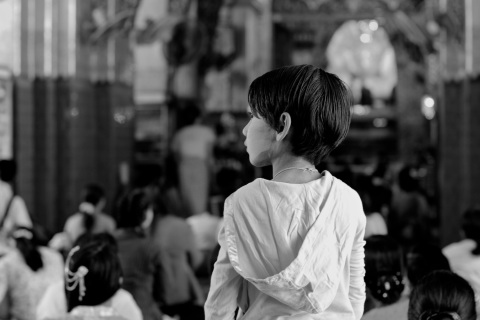
In a golden temple in Mandalay, a young girl is wearing thanaka, a yellow-white-gold colored cream that many Burmese folks wear on their faces. Thanaka is part sun screen and part cosmetic product. It is made from the ground bark, wood, or roots of various trees.

Some ladies hanging out and chatting at the morning market in a small village on Inle Lake. Note: each of them is wearing thanaka on their cheeks.
Thank you all so much for your continued interest and support of the Thailand Burma Flora Fauna project!
Portland: Drawing, Books, and Printmaking!
July 26, 2014 § 8 Comments
Portland – In early June I returned to Portland, Oregon where I’ve been busy balancing various projects, steadily working on print designs, and reading up on Burma.
Earlier this week, I met with some extraordinary local printmakers to discuss printing methods, the finer points of paper varieties, and a production timeline. It’s really exciting that the Thailand Burma Flora Fauna project has entered this stage of production.
Thank you all for your continued interest and support with this endeavor!
Works in Progress
Asian Elephant – After struggling with a design which first featured an extinct variety of rhinoceros and then later the Asian Elephant, I finally abandoned it and went back to the drawing board (quite literally) to rework the picture. Finally, the newer image feels like it’s on the right track!
Sun Bear – The design for a print featuring the elusive Sun Bear is nearly complete! For now, here are some detail images.

WIP – This print features a hilltop monastery based on Mt. Popa, a favorite place we visited in Upper Burma.
Additional Print – I’ve also been making drawings of Bagan, Burma in blue colored pencil. This will potentially be the additional print design that some Kickstarter supporters will receive for increasing their pledge during the funding campaign. (It would be printed in black, as a linocut or letterpress.)
Garden Drawings –This summer so far, I have been spending my off-time gardening and growing vegetables. It’s been enjoyable to draw from the garden as well. If you can’t tell, I’m really into sketching with a cheerful blue color these days.
Reverse Culture Shock + the Big Burma Book Report
Reading – Part of the way I’ve been processing my reverse culture shock (it’s a thing!) and reflecting on this recent time spent in SE Asia has been by avidly reading about Burma and its history.
Curiously, it seems that the more I seek to understand about Burma, the less that I actually know. While the history of any single subject is bound to be complex, for me the shaping of present day Myanmar, seemingly the result of an endlessly labyrinthine trajectory of events, is particularly captivating.
Books – For those of you who would like to broaden your understanding of Burma, I highly recommend reading the two books, in particular. This spring and summer I read Finding George Orwell in Burma and No Bad News for the King— both fascinating and well written documents.

No Bad News For the King details the affects of Cyclone Nargis, which claimed 138,000 lives.
Upon returning to Portland, I reread Burma Chronicles, by Guy Delisle and Quartered Safe Out Here, a WW2 memoir by a Scottish solider named George MacDonald Fraser. Reading Quartered Safe Out Here was a bit too much like eating lunch at the local V.F.W. with my grandfather in the early 1980’s. I also attempted to read some much hyped fiction, The Piano Tuner, but it just wasn’t for me.
Currently, I’m reading 30 Heritage Buildings of Yangon. What I love about this book is that it is a positive and crystal-clear presentation of the current state of heritage architecture in Burma’s former capital city of Yagon.
It offers not only a concise history 30 unique buildings, but also details the potential of these structures available for restoration and renovation. Any one of them could join the ranks of the Strand Hotel, a Yangon landmark– that is, if they are not torn down to make way for newer construction. Follow this link to watch a video of The Strand Hotel.

30 Heritage Buildings of Yangon is a great read so far!
Also, I am currently reading two 100+ year old books authored by V.C. Scott O’Conner. Those books are The Silken East (1904) and another called Mandalay, and Other Cities of the Past in Burma (1908).

I was lucky to find an original 1908 copy of Mandalay, and Other Cities of the Past in Burma (1908), which boasts beautiful photos like this one taken by the author.
The lens through which V.C. Scott O’Conner wrote is now outdated, but none-the-less his books are filled with his fascinating photographs and oral histories that he learned while holding government appointments in Burma in the 1890s.
On deck, I just found a nice hardcover of From the Land of Green Ghosts by Pascal Khoo Thwe, and am searching for a used copy of No Time for Dreams by San San Tin, which is proving a little more difficult to locate for a good price.
Thank you
Thank you all for your continued support of this project! I’m excited to have entered this next stage of production and will keep you updated on the progress as it unfolds.
What’s a Few Earthquakes and a Coup d’etat?
May 27, 2014 § 2 Comments
Thank you to everyone who reached out to me this past week after the Thai military ousted the government in a surprise coup d’etat. For now, all television and radio stations are down (excepting military run channels), there is a nighttime curfew from 10pm-5am, and small street scuffles continue in Bangkok. We shall see what unfolds, but whatever happens next, I hope it is what is best for Thailand.

The lush gardens at the Jim Thompson House. He was Thailand’s silk baron who mysteriously disappeared into the Malaysian jungle in 1967.
Family Visit + Chiang Mai
Prints – It’s been a busy few weeks! Recently, I moved to Chiang Mai, the second largest city in Thailand, to hunker down and focus on the final print designs for the Flora Fauna project. The work is going really well, and I am currently figuring my way through a particularly tricky drawing depicting the Asian Elephant. Once it is resolved, I’ll be sure to share that image with you!
Family – My parents came for a visit and we had a great time touring the country together. It was an important trip so that they will have an understanding of where I have been. Someday we’ll laugh about when they forgot their passports in Mae Sot, and we only realized it on a bus stopped at a military checkpoint leaving town. It is possible they did this just for a little excitement.
Flora – During our travels, we got to see an array of fascinating plants and animals. As usual, I took a lot of photographs- some of which have already proven to be important visual aides for the remaining print designs.
What Comes Next
In one week I’m headed to Bangkok to fly out to Portland, OR. I cannot believe how fast my time here has gone! So far, this has been a fulfilling and fruitful experience, and I am excited about the next stage of the project.
Back in Portland, I’ll be finishing up the final designs, and preparing the images for the next step. I’ve already been in talks with some dynamic, professional printmakers about the best way to see this project to completion.
THANK YOU again for your continued support with my project! Here are a few photographs from recent travels with my family.

Early flora fauna painting in the extensive murals at Wat Phra Kaew, the temple located at the Grand Palace in Bangkok.

Expansive greenhouses at the Queen Sirikit Botanical Garden, outside of Chiang Mai.
The Golden Buddha at Wat Traimit (aka The Temple of the Golden Buddha) in Bangkok, is said to be the largest solid gold statue in the world (3.9 meters tall, and weighs 5.5 tons). It boasts a fascinating history, and was believed to have been made during the 13-14 century in Sukhothai, the ancient capital of Siam.
At some point before the Burmese armies invaded and destroyed the Kingdom of Ayutthaya in 1767*, the golden Buddha was covered in a thick layer of plaster and mosaic glass and therefore hidden in plain sight from the invading army. Thought to be a large statue of little value, it was left untouched in the ruins of Ayutthaya and remained lost for nearly 200 years until it was being moved to a new temple in Bangkok in 1954. While it was being moved the deceptively heavy statue broke the ropes that were being used to hoist it, revealing its true nature underneath the plaster.
*An interesting side note that I learned is that much of northern Thailand, including the city of Chiang Mai, once belonged to Burma. Also, during the invading Burmese army’s retreat in 1767 they marched through the previous incarnation Mae Sot, now located on the Thai-Burma border. The question remains: did they stop at Canadian Dave’s restaurant?
Also, I was told by a Thai friend that ancient Thailand used to boast an abundance of gold, much of which was looted by the invading Burmese Army. The gold cache was then taken back to Burma only to be liberated by the Colonial British while Burma was part of the British Raj or British India.

This photo of the backside of the Golden Buddha illustrates the seams where the nine perfectly interlocking pieces that make the statue fit together.

During a brief, final workshop student SKP drew a cute “lady lion”. The assignment was to focus on mammals in movement, and I loved this drawing in particular.
One of the groups I taught drawing workshops with in Mae Sot is Kick-Start ART. I was happy to see they are closing in on their recent fundraising endeavors. The people who run Kick-Start ART are incredible, enthusiastic, and motivated group. They did everything they could to make my involvement as a volunteer teacher a positive experience.
Check out their fantastic video to get a glimpse of what they provide and the situation that many of the migrant Burmese students are coming from. The teachers in the video were some of my favorite students, and were such a joy to work with!
Thank you for your support!
Design No. 4 – The Great Eastern Egret Over Inle Lake
May 12, 2014 § 12 Comments
The fourth design for the Thailand Burma Flora Fauna series is complete! Today, I’d like to talk about the process behind the making-of this image, as well as share some photographs from Inle Lake, where the scene is set.
The Print – This print design features the Great Eastern Egret flying over Inle Lake (pronounced in-lay), located in Upper Burma. It is the last print to focus on a flying creature as a main character, and I’m already busy at work on the final four designs that star some pretty stellar and unique mammals.
The Characters – Inspired directly by my own experience, this design was cobbled together from my sketches, photographs, and memories of Inle Lake. The elements include a fisherman on his wooden boat, smoke rising from a burning fire high upon the mountain (upper left), fog and mist rolling between the mountains, a flock of egrets in the sky, fisherman and farmers’ houses on stilts among the floating gardens of Inle Lake, and a mountaintop monastery.
Why an egret? – While varieties of egrets can be a common sight in the US (often seen along the coastlines of Oregon and California) I was struck by the elegance and majesty of these birds against the idyllic backdrop of Inle Lake. It’s no wonder herons have been a staple character in the canon of Japanese printmaking… The sight made an impression on me, and I felt that it was something that I wanted to remember and honor.

Everywhere we went in Burma was the ever present burning of fields, forests, grasslands, and brush debris. Because of this and the unregulated pollution from vehicles and cities, the air quality across SE Asia is very poor.

Asleep? No, just a bright sun. The two men behind me have a boat filled with mud dredged up from the canal- an essential chore to keep the waterways around the lake flowing.
Egrets and Herons, Storks and Cranes – What’s the difference? – From what I have read, egrets are essentially a type of heron, but are in a different family from cranes and storks. They are smaller, more svelte, and fly with their heads in a “S” shape, rather than straight outwards like a crane. Egrets were once nearly hunted to extinction for their beautiful plumes, but the species has made a comeback.

The famous floating gardens of Inle lake are literally pieces of floating earth and vegetation staked into the shallow lake bed with tall bamboo poles.

Seagull attack or pleasure ride? Local Burmese folks feeding a frenzied flock of seagulls to pass the time. Look closely and you can see the food being tossed up to the gull.

Our longboat driver on the day he and I were stuck out on the lake with engine trouble. Sorry, Mother Earth! This is what zero regulations on engine emissions looks like.

At In Dein monastery, there are many pagodas topped with thousands of wind chimes- the sound of which is quite lovely. I hiked up there alone and found the temple empty except for a few stray dogs and two men restoring crumbling bricks.
Hiroshige – This design was surprisingly challenging. I had hoped for a simple image of an egret set against light, cascading hills. However, it just wasn’t quite striking enough from across the room. So, I made upwards of forty (yes, forty) variations of this design to get it to feel just right, and finally settled on a dusk / dawn image with the hills in silhouette.
While I was working out the kinks I looked to Hiroshige, an Edo period Japanese printmaker, to help point the way. I have always loved his prints, but after intensely studying his landscapes I have a newfound respect for his work.

During a workshop in Mae Sot, students JK and PD pore over books of master printmakers Hiroshige and Hokusai before drawing sketches for their own designs.
Thank you! – Thank you for reading and for your continued support with this project!
Design No. 3 – Hokusai + Richard Scarry + 1980’s Aquatic Wildlife Poster
April 28, 2014 § 5 Comments
The third design for the Thailand Burma Flora Fauna series is complete! My hope was that it could be a combination of Edo Period printmaker Hokusai, the busy children’s books of Richard Scarry, and a 1980’s Aquatic Wildlife Poster. (You remember the kind– filled to the brim with whales, coral and every kind of tropical fish imaginable…)
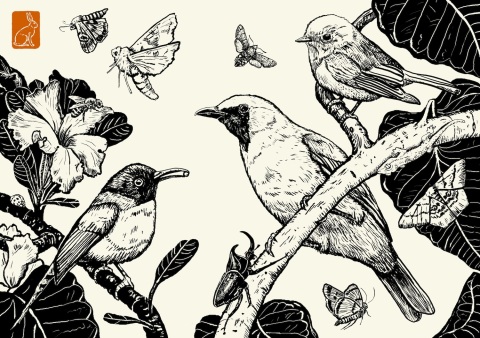
Thailand Burma Flora Fauna print design No. 3.
The Cast
Birds – The three main characters of this print design are the birds (from left to right): the Green Tailed Sunbird, the Blue Winged Leafbird, and the Sapphire Flycatcher.
Insects – Other creatures include five varieties of moths and butterflies, including the Hummingbird Hawk Moth (located at the top, middle) and the angular-shaped Geometer Moth (located on the far right). Also shown are the Asiatic Honeybee (Apis Cerena), an Asian Ladybird Beetle (SE Asia’s variety of ladybug), a Rhinoceros Beetle (children here like to catch these and keep as pets), plus a small tropical gecko.
Trees – The Bodhi (pictured on the right with its heart shaped leaves and long narrative history) and on the left a variety of flowering Plumeria which I found and photographed in Bagan, Burma.
Plumeria
The variety of flowering tree that I found in Bagan had the same leaf and trunk structure as Plumeria, but the flowers were softer, resembling Hibiscus.
Plumeria is actually native to Central and South America, but it has long since been naturalized to SE Asia. Across Asian folklore Plumeria is often associated with ghosts, vampires, and cemeteries, but in India garlands of its flowers are exchanged during wedding vows, and in Thailand and Burma it is often found at Temples. Also, the Hummingbird Hawk Moth (aka Sphinx Moth) is attracted to the Plumeria’s nighttime fragrance and helps to pollinate it.
Studies for the Design
Once this image started to get visually busy I decided the only way it could work would be to make it as bustling as possible, and by doing so find a balance. Pictured below are some sketchbook drawings working out the composition.
The Museum of World Insects and Natural Wonders
Today I visited the Museum of World Insects and Natural Wonders in Chiang Mai, Thailand. It was incredible, and I was fortunate enough to meet one of the founders of the museum, Mrs. Rampa Rattanarithikul.
She is Thailand’s leading expert on insects. Since the 1950’s she and her husband have dedicated their lives to insects, and specifically, the mosquito, in an effort to understand and eradicate malaria. They have researched insects all around the world, and spent years working for the Smithsonian in Washington DC. We had a very pleasant conversation about her life and work and, of course, insects.
Dr. Rampa asked about my work- so I shared about my print project and showed her some of the designs. She then offered that I could come back to do some drawing from life in the museum, which I will happily be doing that later this week. All of the insect photos shown here are from today’s visit.
Thank you again for all of your support with my project!
Upper Burma – Photography
April 21, 2014 § 6 Comments
This week I’d like to share more images from our travels through upper Burma. I’m adding the finishing touches to the third print design for the Thailand Burma Flora Fauna series which I am excited to share with you all next week!

On Inle lake, a fisherman deftly uses his leg to paddle his wooden boat, freeing up his hands to cast and pull in his fishing nets.

A weaver uses lotus thread, cotton, and silk (thread all handmade in their shop) to operate a foot pedaled wooden loom to make beautiful, intricate longyis (traditional Burmese attire).

A horse cart in dusty Bagan, Burma. (There are no filters on any of my photos– just great lighting and beautiful colors there!)

Sun protection! After seeing hordes of bleary eyed, sun burned and lobster-like tourist staggering about Nyuang Shwe, we wrapped ourselves up while out on Inle Lake.
The floating gardens of Inle lake are quite literally that- floating garden beds which are staked into the bottom of the lake with tall bamboo poles. (The lake itself is only about 3-4 meters deep in these parts.) This way local farmers are able to grow assorted vegetables (like tomatoes and eggplants) directly on the surface of the water– talk about hydroponics…
At one point, at the insistence of our driver, I climbed out of our longboat and walked on a patch of spongy, plant entangled earth. Beneath each foot I immediately (but slowly) began sink into the lake- what an odd sensation!
In the photo above you can see one of the thatched bamboo houses, up on stilts, in which the local farmers live and work.
One of my favorite moments from Upper Burma was an unexpected visit to a mountaintop pagoda along the road to Bagan. This pagoda is currently being restored and re-gold leafed, so it is covered in a bamboo scaffolding, which was then sheathed in woven mats from top to bottom.
We arrived there in the dark of night after all of the stalls had shut down except for two women selling garlands of white flowers. In our bare feet we padded up a long, worn, stone staircase to the summit– up past families noiselessly eating dinner around circular tables. Sleepy cats lazing on wooden window sills. A monk who sat in his abode and stared blankly at us with even keeled indifference.
Atop the hill was an immense silence under a black starry sky. We could see the vast rolling plain from which we came, and Mt. Popa on the horizon– small plumes of smoke rising about the valley. The crescent moon behind foggy distant clouds.
The quiet was punctuated only by the occasional flapping of prayer flags atop the pagoda, and the nearly inaudible murmuring of a woman who was intensely praying and gently rocking back and forth in front of a small statue of the Buddha. It is only a projection, but I got the feeling like she was working her way through a personal crisis, up here alone at night and completely unaware of our presence. It was nice moment, and a good memory– something I’ll never forget. Below is an illustration from my travel sketchbook of the woman praying.
Making authentic gold leaf by hand takes a tremendous amount of time and human energy! The hammers alone are very heavy, so the men brace themselves against wooden rests behind them and spend their days hunched over flattening out small packets into leaf (while somehow not hammering their feet which barely straddle the wrapped gold).
I did purchase gold leaf from this shop with the possibility of using it to sign the first edition of prints in this series. Maybe– we’ll see how it looks at that stage.

Mt. Popa boasts a jutting spire of rock with large monastery atop the mountain. You can also see some of the burning fields / forests that are adding to SE Asia’s current air pollution crisis.
In the recent past, Jumping Cat Monastery on Inle Lake was a place where Buddhist monks trained cats to do an assortment of tricks, like jumping through hoops. Unfortunately, tourists began showing up and asking / demanding that the monks make the cats perform for them.
As you might expect, performing for tourists isn’t very monk-like, so they have since discontinued the practice. Nowadays, monk and cat simply live together at the monastery. Clearly you can see in this cat’s eyes that she is not interested in performing for us, but she could if she wanted to.
Thank you for reading and for your continued support with my project!
Burma Banteng – Cattle and Aloe in Bagan
April 14, 2014 § 7 Comments
The second contender for the Thailand Burma Flora Fauna print series is complete! Today, I’d like to share some thoughts about that image, and also say thank you to everyone who has been reaching out to me after I post these updates. I appreciate all of your support and kind feedback with this project!
This image is a night scene illustrating the Burma Banteng, a species of wild cattle found across Southeast Asia. One of my goals for this project was to allow first hand experience to inform this body of work, which I feel it already has, tenfold.
Included in this image are a number of specific plants and trees, human-made structures, and other visuals I witnessed during my travels. Talk about “refilling the wellspring”, so to speak…
Why choose something as mundane as cattle?
One – As part of my rubric for the series, I determined that it would be too predictable to only represent animals that were exotic or endangered species. I wanted some animals that were thriving, and at least one type that lived among human beings. Like the elephant, cattle have had a complex role in the development of civilization over several millennia, and I wanted to honor that role.
Two – Banteng, or tembadau, are one of the animals that really stood out to me while I was in Burma. We saw so many different breeds being herded among the ruins in Bagan. Some were wilder looking varieties– buff colored oxen with wavy viking-like horns. But I found that the Bali cattle (domesticated banteng) were the most visually striking with their humps, floppy ears, and large, peaceful doe eyes.
Bagan was easily one of the most incredible places I have ever been, and I was surprised at how arid upper Burma is. Think: dusty red earth, dry stream beds, and a thriving variety of plants and trees acclimated to a desert climate. In the image, I included toddy palms, eucalyptus, and acacia trees, as well as cactus and aloe vera plants among the ruins of the temples.
Also, while we were in Bagan the Orion constellation was prominent in the night time sky, and the crescent moon would lay flat on its back in a way that appeared unusual to me. I wanted to remember these details so I included them in the print design.
Bagan – Bagan was the ancient capital city of what would later become Burma. Between the 11th and 13th century thousands of temples, monasteries and stupas were constructed there, of which there are still over 2,200 pagodas left today.
A couple of weeks ago I participated in local Mae Sot NGO Kick-Start Art’s annual auction. It raises funds for the organization by asking local artists to make pieces inspired by an artwork made by one of the school children attending its art programs.
I chose two kids’ pieces that humored me– one depicting a joyful banana and another of a sad mosquito. For which to accompany them (and to keep within the logic of the original artwork) I made images of a morose banana and a happy mosquito. It was a lot of fun, and both sold for a good cause.
Currently, I’m busy at work on the fourth and fifth Flora Fauna images. The third image design is complete, but I am giving it a few days for touching up before I share it.
Thank you for reading and for your support!
Burma – Part 1
March 31, 2014 § 10 Comments
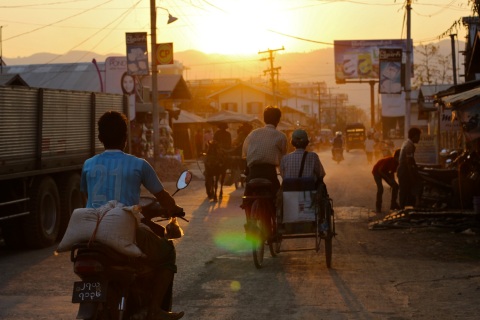
Old diesel trucks, tractors, motorbikes, trishaws, bicycles, and horse and ox driven carts are all modes of transport in Burma. Pictured here is Nyaung Shwe, on Inle Lake, one of my favorite places we visited.
Burma was incredible. For me, being there was a truly profound experience. Each day potentially ranged from easy to difficult traveling. At times it was amazing, mundane, frustrating, beautiful, astonishing, annoying, troubling, and absolutely wonderful. That said, I am unsure of how to even begin to sum up my time there.
What I do know is that this experience has led to a deeper understanding of my students, where they come from, and where Burma is at during this time of transition.
We saw multitudes of fantastic plants, animals, and landscapes– all of which have already greatly enriched the direction of my Flora Fauna print series. Think: groves of tall eucalyptus trees and gigantic aloe vera plants in the arid plains of upper Burma. Cows like skeletons being herded down the highways by barefoot child shepherds. Enormous, striking moths and butterflies (I’m 99% sure we witnessed a Mystical Bhutan Glory on Mt. Popa, but it was there and gone before we could blink an eye.) I had my sketchbook with me and made drawings and notes of everything that I could whenever we had down time. I’ll share some of those drawings soon.
We thought a lot about the question of why we travel– as more often than not traveling can be quite difficult. (An example: (An example: On a ten hour bus ride with no toilet on board and a single “bathroom” stop, the driver and his minions had picked up so many people along the way that even the rows between the seats were sold out and filled with men, women, and children standing or sitting on the bus floor on little plastic stools. Over winding, narrow mountain roads people were vomiting onto the floor which then ran under our feet and smelled awful. But we couldn’t open the windows because when you did the bus filled with choking exhaust fumes, and so on and so forth). After a while you end up asking yourself, why do I do this at all?
Well, my conclusion is (as it always seems to be) that there is an importance of seeing something with your own eyes that can truly broaden your understanding of a place. Or if nothing else, traveling can help a person to have a new perspective on life– and so it did!
This week, I’d like to share a small selection of what we saw on our trip through Burma.

In Inle Lake (pronounced in-lay), we hired a boatman for a few days to take us to interesting and hidden locations around the lake. This is the blue long boat with which we traveled.

A very cool looking tourist on the famous U Bein bridge in Mandalay. U Bein is the longest teakwood bridge in the world and is ubiquitous with images of Burma.

Hilltribe women selling vegetables in a market on Inle Lake. Many women here wear brightly colored hand woven scarves on their heads.

A typical scene in Burma: a 1940’s-1960’s diesel truck with an exposed engine being stacked high with goods to be transported (sometimes stacked 2-3 times the height of the actual vehicle). Once it is packed to capacity, the truck then becomes a transport for people who sit on the top or stand hanging off of the back. We saw people traveling great distances this way despite the heat of the day or the dark of night.

At a bronze casting studio, a wax carver takes a moment to light his cheroot cigar. We visited many artisan shops and witnessed some fantastic craft production techniques. After the initial lightweight earthen frame is covered with a completed wax statue of the Buddha, a clay mold is made around the wax. The entire mold is heated by fire and the melted wax is drained out. That clay mold is then is completely buried in the ground with one small entrance hole poking out of the earth. They then pour molten bronze into this hole. Once cooled, the bronze pieces are taken out, assembled, cleaned with a grinder, and polished up for sale. Quite a process!

Mandalay was so vibrant and alive that it made Bangkok seem a little slow paced. People everywhere doing their thing!

This is a long exposure photograph (much brighter than with the naked eye) of Mandalay at night. The streets of Mandalay are largely dark and unlit except by the headlights of motorbikes and cars, as shown here. Blackouts in Burma are still a frequent occurrence.

A weaver in Inle Lake makes thread from crushed lotus reeds using a hand crank and a bicycle wheel. Pretty ingenious!
Burma Bound and the Mystical Bhutan Glory – Process!
February 26, 2014 § 5 Comments
The first contender for the Thailand Burma Flora Fauna print series is complete! Today, I’d like to share some of my process with you, give a brief update on student workshops, and let you know about my upcoming travel plans into inner Burma and Laos at the end of this week. Wifi in Burma is rare, so the next update will be in late March upon my return to Mae Sot.
The Mystical Bhutan Glory (what a name!) was a fascinating creature to research. This swallowtail butterfly was recorded in the 1920’s at 9000 ft in the Himalayas. It is rare due to over-collecting and the destruction of its habitat and is now considered to be endangered (though the numbers are unclear). Large for a butterfly, it can measure up to 11cm (4.3in).
As a defense the Bhutan Glory feeds upon the poisonous Indian birthwort plant. It absorbs the poison, which predators can sense and then know to avoid. I thought it was appropriate to pair it with the poppy flower, which has its own complicated history with Thailand and Burma.
I am experimenting with different chops (traditional signature stamps) and am considering including gold leaf from Burma as an addition to the signature (as seen in the image, above).
Process – My process is about expansion and contraction. That is, first being completely wide open and allowing myself the space to summon and sift ideas. This is followed by a deliberate process of honing in on the strongest ones. Once I have settled on an image I work it (and rework it) until it feel right to my eyes.
In the beginning of a project I fill sketchbooks with loose sketches called thumbnails drawings, named so for their small size. I am a firm believer in drawing thumbnails– if a composition does not work well at an inch by an inch, why would it look good on a large scale?
Once I have chosen the composition I draw the image digitally (directly into photoshop) using a tablet and pen tool for my computer. For me, this is a great way to work as I am able to experiment while using the most of my time and energy. Once I am satisfied with the image, I can redraw and refine it on paper.
Student Workshops – The workshops have been going really well. They’re enjoyable to teach and sometimes challenging when true language barriers surface, but overall, they feel like a productive sharing of knowledge. For me, the teacher training has felt the most fruitful so far, as all of these young artists have the desire to teach and pass on what they learn to their younger peers.
It is so hard to choose images to share as there are so many good ones. Here are a few for now.

Working with younger students at Kick-Start Art is important as most do not have regular access to any art education or drawing classes. Exposure to new modes of thought can be really valuable to the right student.

Student making a batik painting at the Puzzlbox using a copper tool which slowly drips out hot wax onto the stretched cotton canvas.

The teacher/staff training with Kick-Start Art was the best! Pictured from left: KK, Jess, PD, JK, and Felix.
Travel – My lovely traveling companion and I are about to head into inner Burma, and then onto Laos. I can’t wait to see it with my own eyes. In anticipation, I’ve been reading Finding George Orwell in Burma, a book I highly recommend to anyone who is interested in the history of the country.

Reading this beautiful and insightful book just days before my trip into inner Burma feels a bit like reading ghost stories before going to a haunted house.

“Wait, where are you again?” Good question! Here’s a map with a few upcoming travel destinations. Map source: BBC’s Wild Burma.
Among other locations in Burma, we’ll be headed to Mandalay, Bagan, and Inle Lake. Then off to Vientiane and Luang Prabang in Laos. It is my hope and goal to absorb as much as I can visually and to collect images that can be used in this print series as well as in my other work.
My next update will be posted after my return to Mae Sot in late March. Thank you all for your continued support!
*Special thanks to my old friend David who sent me a mellow, uplifting music compilation that carried me through the end of this first drawing. It was much needed and much appreciated!*
Flora / Fauna – Concepting and Workshops
February 17, 2014 § Leave a comment
This past week in Mae Sot has been productive. I’ve given individual artist training, conducted Flora / Fauna drawing workshops, and am currently engaged in the initial concepting stage for the print project!
So far, the most difficult task is in choosing which plants and animals to represent. I’ve designed a rubric to help me whittle down the candidates. My hope is to create a dynamic group of images with a well rounded cast of creatures, and it definitely helps to have some self-imposed guidelines. I’ll keep you posted on the progress and will share some of my initial process drawings once I feel that the concepts are strong enough.

Drawing from a cast concrete sculpture helps students understand how light falls onto the different planes of the human head– in the drawing room at the Puzzlebox Art Studio.
This week I’ll be conducting three Flora / Fauna drawing workshops. Today, I gave one such workshop to a group of young adults who are all themselves art teachers for a local Mae Sot based project called Kick-Start Art. It was the best workshop so far! They were enthusiastic and fun, and all of their work is really strong. I’ll share more of those images next week.
Here are some more day to day shots from my life in Mae Sot. Thank you all for your support!
Flora Fauna Design Workshop!
February 10, 2014 § 5 Comments
The first drawing / design workshop related to the Thailand Burma Flora Fauna series went really well! Today, I’d like to share some photos and stories from that workshop, as well as some more visuals from my life here in Mae Sot.
As a reminder, the artwork shown in this post is all student work– the images for the final print series will be designed and drawn by my hand alone.
Workshop – With the translation help of my talented artist friend Sein Sein Lin, I was able to conduct my first workshop with the apprentices at the Puzzlebox Art Studio. Sein Sein Lin is a teacher who has an incredible gift for language, a sunny disposition, and a great sense of humor.
As a starting point, I asked the students to base their compositions off of the prints of the Japanese artist Hokusai. As they worked, SSL and I gave them individual guidance as each student is at a different skill level.
Overall the workshop was positive and fun! It was a challenging exercise for the students– and for myself it was a good re-introduction to teaching. Later in the week we worked on individual training, and enjoyed a day of epic deep cleaning and organizing at the Puzzlebox.
Lost in Translation – Below is a short excerpt from a group discussion from the workshop. This passage illustrates how meaning can get lost in translation (with a bit of cultural comedy).
Me: What are Burma’s most iconic animals?
Student 1: Cat.
Me: Hmmm, yes, but what I mean is- what are the the most iconic, meaning: famous, popular, or cherished animals?
Student 1: …
Sein Sein Lin (SSL): She likes cats.
Me: Ok. What other animals are cherished in Burma?
Student 2: Water Buffalo.
Me: Yes! Good one. What else?
Student 3: …
SSL: Lions.
Me: There are lions in Burma?
SSL: Yes, lions are very famous animals in Burma– we have them in the zoo.
Me: Oh, haha, yes. I mean: famous animals native to Burma, like the tiger. What about turtles? Turtles are cool. Do you like turtles?
SSL: Oh, yes, we love turtles!
Me: Nice.
SSL: We love to eat them.
Me: Oh… right.
So, people everywhere like cats, and turtles make for good soup. It’s good to be reminded that different cultures value different things.
Also, interesting, Sein Sein Lin said that Burma had nothing like a National Geographic magazine. So, it wasn’t until foreigners starting visiting Burma and then later publishing their photographs from the mountains and jungles that people really knew what kind of wildlife was inside its borders.
Thailand – This past week I had a mysterious fever that came and went, and found a dead, venomous snake in our yard.
I’ve begun my drawing and concepting process for the Flora Fauna print series and am truly excited about where it’s headed. I’ll have some images from that process to share with you soon! Thank you all for your continued support!

I’ve been steadily collecting beautiful objects and artifacts to paint as still lives in my on-going oil series, Objects and Oddities from the Thai-Burma Border.
Back in the Land of Smiles
February 3, 2014 § 4 Comments
Here! – It’s wonderful to be back in sunny Thailand! This past week has been a whirlwind of getting my feet on the ground here in Mae Sot, while my mind and body readjust to the Thai culture, language, time change, and the climate of Southeast Asia.
Project – Last week I began working with the apprentices at the Puzzlebox Art Studio, and have conducted the first drawing / design workshop related to the Thailand Burma Flora Fauna series. The workshop was productive and challenging, and a great beginning to the project.

For the first workshop, I had the apprentices use the woodblock prints of renowned Japanese artist Hokusai as a reference for their design compositions.
More Soon! – The next update will include a detailed description and photos of the finished work from that first workshop, but today I wanted to set the scene of what the world looks like where I am currently located.

A typical view of a street in Mae Sot, decorated with a ceiling of yellow flags celebrating the Chinese New Year.

The evening light illuminates the smog over Chiang Mai. This photo was taken from a small propeller plane. The air quality here can be poor at times. No filter on this photo!
Thai Culture – The very briefest note on Thai culture: Thailand is known as The Land of Smiles. It is a devout and predominantly Buddhist nation (about 95% Buddhist). Depending on your location and the season the climate can be very hot, and either very wet or dry. The mosquitos here are a plenty, and the food is amazing and spicy.

Double dragons guard the entrance to Wat Phra Singh (Buddhist temple) in Chiang Mai.

Interesting times: Street scene showing Thai protesters waving flags during a parade before the February 2nd election, and migrant Burmese workers in trucks.
Challenges So Far
1) Language – Burmese batik artist Sein Sein Lin and I have begun work on The Rosetta Stone of Art Vocabulary. We made a list of 250 important art related vocabulary words including techniques, tools, styles, media and art movements. (Think of terms like: drawing, charcoal, palette knife, monochromatic, kiln, etc.)
The objective is to have a complete vocabulary list of terms translated into English, Burmese, and Thai. This will enable artists from each culture to more easily communicate whenever there is a language barrier.
2) Assessment – The Puzzlebox Art Studio is in a place of transition. For varying personal reasons many of the Burmese apprentices have had to leave their positions there. I have made an initial assessment of the studio production line as one way I can be of use to the Puzzlebox is to organize the space and to give suggestions on how to streamline the workflow.
3) Personal Studio – Currently, I’m searching for the right workspace in which to set up my art studio here. I am flush with ideas for the Thailand Burma Flora Fauna project and now just need a space so I can get to work!
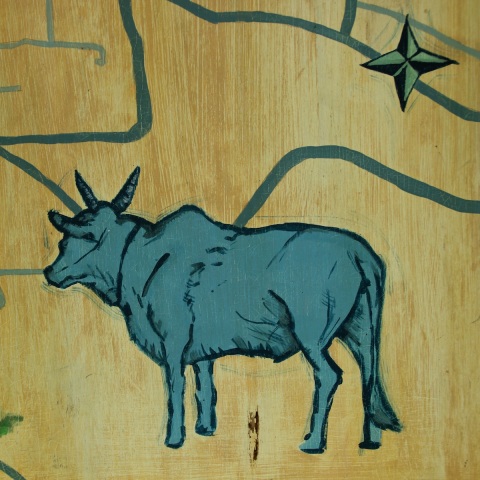
Detail of a mural I designed in 2011 that was executed after I last left Mae Sot. It was painted by my former Puzzlebox apprentice Jaw Saye. So enjoyable seeing this for the first time!
Thank you – Thank you all for your continued support! Please feel free to comment and dialog. I will do my best to answer any questions you might have about the Thailand Burma Flora Fauna project as it unfolds.
Thailand Bound!
January 21, 2014 § 4 Comments
Thailand – This week I arrive in Thailand! I am thrilled to return Southeast Asia and feel so much gratitude towards everyone who supported my printmaking project. I’m excited to get back to sunny Mae Sot, and to begin collecting and drawing images for this series of prints!
Research – The Thailand Burma Flora Fauna series has given me a great reason to conduct research on both the plants and animals of Thailand and Burma, and also on the works of master printmakers from the past, like renowned Japanese artists Hokusai and Hiroshige. Below, you can see a Hokusai woodblock print where he paired a swallow with a hibiscus flower.
The BBC has recently produced a brilliant documentary series called, Wild Burma: Nature’s Lost Kingdom. You can watch it here. It’s got incredible footage of many rare plant, animal, and insect species inside Burma. From this documentary, I learned that 95% of all the forests of SE Asia have disappeared, and Burma now boasts 50% of those remaining forests within its borders.
I’ve also been poring over old books illustrated with great woodblock engravings. Titles like A General History of Quadrupeds (1885) and Mammalia: The Mammals of Lower India and Burma (1888) have been helpful and fun to look through.
Personal Timeline – From my last update, you may remember that my trip was delayed for medical reasons. Long story short: I cut my hand, got an infection and had to have surgery. It healed, and was followed by six additional weeks of physical therapy. I’m happy to say I am now on the mend and nearly back to 100%.
What I missed out on in December was a planned trip to Burma with some loved ones. My good buddy Cristina took this sunrise photo over the ancient ruins in Bagan, a place I dearly hope to visit during a trip to Burma this coming March.
Thank you all again for your continued support. Next update: Thailand!

